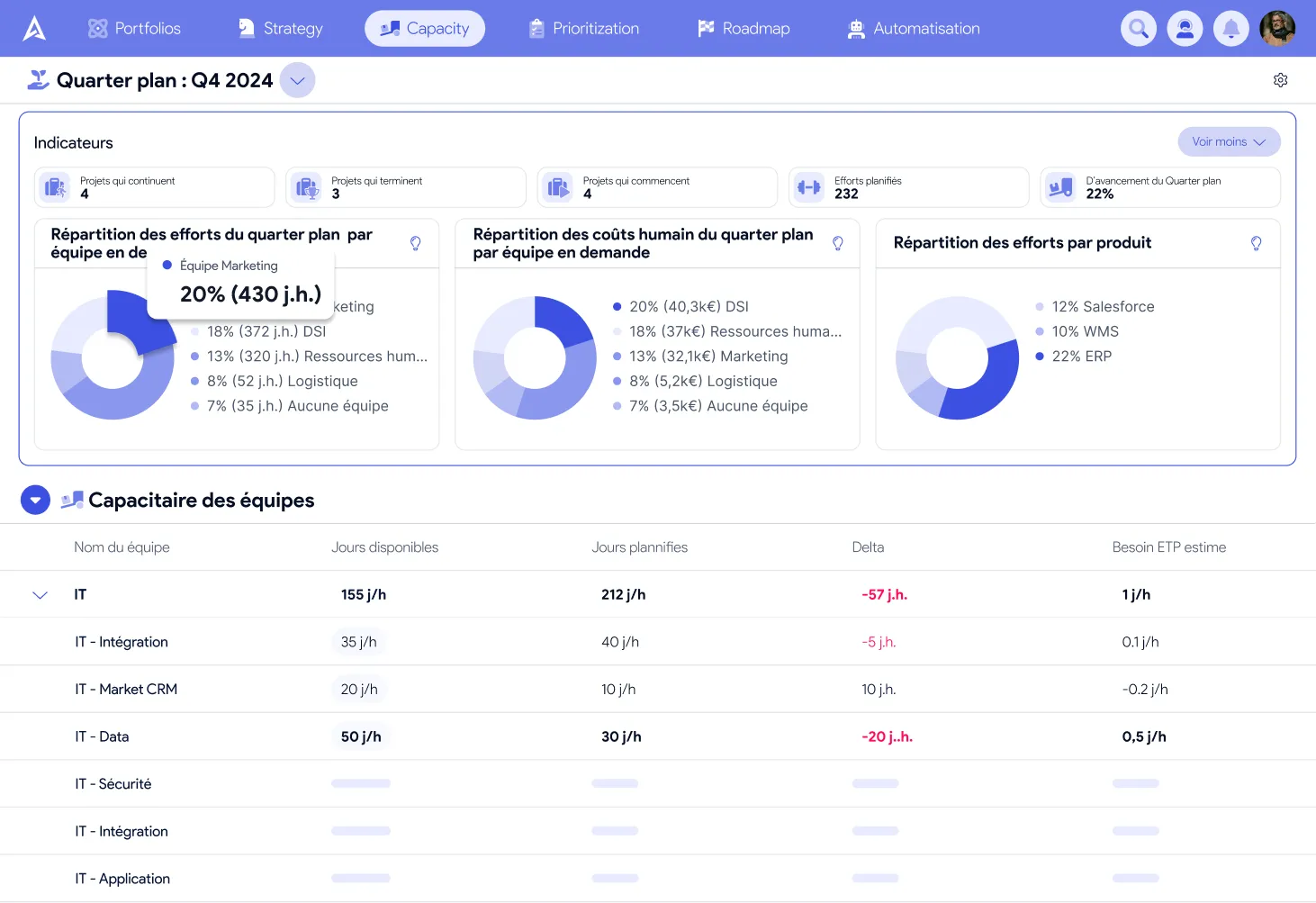Aligning capacity to do and incoming requests thanks to Quarter Plan


When Sébastien joined Altavia, the company laid out a transformation plan for 2030 and its scope, and divided it into nine main streams. Sébastien's role as a Group CIO? structure this plan in the form of roadmaps of major IT projects.
But the CIO quickly encounters challenges in terms of project prioritization and capacity - not to mention visibility and communication problems around this transformation plan.
It must be said that the structure of the organization makes it quite complex to implement. Sébastien can rely on more than 40 employees in the IT Group, but must also collaborate with other players:
Faced with the organization's ambitions in terms of transformation, Sébastien is taking a stand: that of restructuring his roadmaps quarterly, in a Quarter Plan approach. Its objectives: to facilitate the prioritization of departments, to avoid overloading teams (and therefore, the failure of projects), and to promote a genuine transparency approach on what may or may not be achieved in the coming periods.
Here is a look back at a first Quarter Plan that is promising for the future.
Altavia's transformation plan is mostly made up of long-term projects, involving numerous external structures (firms, integrators, service providers, etc.).
To follow these projects, Sébastien first sets up a bi-monthly review where everyone prepares their PowerPoint presentation. During this meeting, each of the participants highlights their problems, their weather, their progress, their budget consumption... Result: these bi-weekly sessions last 2 hours, each one talks ten minutes about his project.
Initially, this ritual doesn't work too badly.
And then, as in any business transformation, projects develop, overlap, fall behind schedule, and are suspended due to lack of resources. Sébastien and his team then became aware of the many hidden inter-project dependencies.
Sébastien then fully understands the challenge facing him.
He notes:
Sébastien starts by testing initial actions to deal with the problem.
On the infrastructure, data and cybersecurity side, he is setting up Jira. The tool allows him to better document the run and the sprints, but also to trigger some transformation issues (in particular the modernization of infrastructures).
On the application side, he designs a macro-planning to try to manage the memberships and milestones of the various projects. This schedule helps him gain a bit of visibility... but for a short time. He quickly realizes that the adhesions and links between teams make this type of tool unmanageable, as projects have such an impact on each other.
Sébastien needs to have a more macro visibility on the progress of projects, to be able to manage the capacity to do so and to set up a more structured demand management. And that's where AirSaaS comes in.
Sébastien makes the decision to cut Altavia's transformation plan more finely: he sets up a Quarter Plan. He then embarks on an approach that allows him to obtain intermediate deliverables, on which he (and at the same time his top management) has more visibility, and which give him the ability to rearbitrate priorities over time.
Thus, he can visually expose capacity to his peers in relation to requests, and therefore involve them much more easily in the continuous prioritization of projects on the basis of capacity, and ensure more rigorous management of demand.
He launched the Quarter Plan approach accompanied by the AirSaaS teams. First, workshops are organized: they make it possible to precisely understand the teams' pain points.
Then the solution AirSaaS Quarter Plan is deployed.
Thanks to the tool:

The first Altavia Quarter Plan day takes place on 1 April. All IT teams and all project leaders collectively prioritize upcoming deliverables during the quarter, minimize the risks of excesses, and commit to their Quarter roadmap.
From the first day of Quarter Plan, the teams noted the benefits of this approach and of the AirSaaS tool:
Following this first Quarter Plan, Sébastien warns his teams: now, he only follows projects on AirSaaS. A smart way to create momentum around the tool, and to engage teams around the platform. At the heart of the approach, AirSaaS becomes the truth zone on a given project, and in particular on transversal projects.
Now, Sébastien is waiting to see the results for the next quarter.
Enough to give more credibility to the IT department among businesses, and to improve Sébastien's reporting.
And for that, Altavia will be able to count on the support of AirSaaS until the end of 2025, on at least three Quarters.
Altavia is the first independent communication and marketing group for retailers and brands. Its activities include agency strategy, the development of points of sale, and procurement strategy (i.e. supporting customers in the purchase of print media, carrying out carbon assessments, etc.).
“Il y a bien entendu un grand nombre de risques au sein d’une entreprise, dont le fameux risque financier. Néanmoins, le risque IT et le risque cyber sont devenus, en quelques mois, les risques numéro 1 de la liste.”
CIO